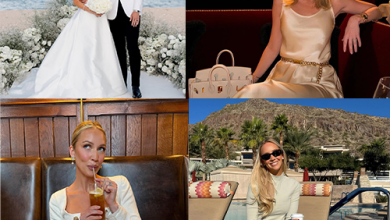
Coco Chanel Biography
Coco Chanel (born August 19, 1883 in Saumur, France; died January 10, 1971 in Paris) was a French fashion designer who dominated Parisian haute couture for over six decades.
Her elegantly informal designs pushed women to forgo elaborate, unpleasant clothing, such as petticoats and corsets, that were common in early twentieth-century fashion.
Her now-classic innovations included the Chanel suit, the quilted pocketbook, costume jewelry, and the “little black dress.” S
he was also recognized for the iconic perfume Chanel No. 5.

Coco Chanel Profile
| Born | Gabrielle Bonheur Chanel 19 August 1883 Saumur, France |
|---|---|
| Died | 10 January 1971 (aged 87) Paris, France |
| Resting place | Bois-de-Vaux Cemetery, Lausanne, Switzerland |
| Occupations |
|
| Known for |
|
| Label | Chanel |
| Awards | Neiman Marcus Fashion Award, 1957 |

Coco Chanel’s Early Life
She was born Gabrielle Chanel, but her surname (Chasnel) was misspelled on her birth certificate.
Her parents were Eugénie Jeanne Devolle Chanel, a laundrywoman, and Albert Chanel, a street vendor.
The family, who eventually numbered six children, lived in poverty while wandering about the French countryside.
After her mother died in 1895, Gabrielle Chanel, 11, was taken to an orphanage managed by a convent in Aubazine. It was there that she learned to sew.
Chanel traveled to Moulins at the age of 18 and studied school while living in a convent.
In 1902, she started her own business as a seamstress. Chanel was also a café singer at the time. Despite not being a particularly great singer, she was a well-liked entertainer noted for her personality.
While the origins of her moniker “Coco” are unknown, some believe it refers to numerous songs she performed, including “Ko Ko Ri Ko” (“Cock-a-doodle-doo”) and “Qui qu’a vu Coco?” (“Has anyone seen Coco?”).

Fashion Empire “My life didn’t please me, so I created my life.”
Chanel led an active social life and had affairs with several affluent men, most notably Arthur (“Boy”) Capel, with whom she was in a relationship until he died in 1919.
In 1910, with his financial aid, she founded Chanel Modes, a small millinery store in Paris.
Two years later, she opened a boutique in Deauville, France. She later offered basic apparel, such as jersey sweaters.
At the time, jersey was a low-cost fabric extensively used in men’s undergarments. Chanel, on the other hand, used the fluid material to create functional yet exquisite designs, many of which were inspired by menswear.
Within five years, her original use of jersey to create a “poor girl” image had piqued the interest of powerful wealthy ladies seeking an alternative to the popular corseted fashions.
Chanel’s designs, based on her philosophy that “luxury must be comfortable, otherwise it is not luxury,” emphasized simplicity and comfort, and they transformed the fashion business.
Chanel introduced the “little black dress” (often known as the LBD) in 1926, further transforming fashion.
While Chanel was not the first fashion designer to utilize black, it was traditionally designated for mourning or more formal apparel.
Chanel’s black dress, on the other hand, was highly adaptable, effortlessly moving from day to evening with the correct accessories such as the costume jewelry she frequently wore.
The LBD was praised for its simplicity and widespread appeal.
About Henry Ford’s breakthrough Model T car, American Vogue dubbed the tiny black dress the “Ford of Fashion,” and it immediately became a fashion mainstay.

Chanel No.5 “A woman who doesn’t wear perfume has no future.”
While Chanel was enormously successful as a designer, Chanel No. 5 served as the financial foundation of her business. In 1921, she collaborated with Ernest Beaux, one of France’s most gifted perfumers, to create an incredibly successful perfume.
The perfume’s name is supposed to be derived from a sequence of smells developed by Beaux for Chanel to sample she chose the fifth, a blend of jasmine and several other flower scents that were more complicated and mysterious than the single-scented perfumes on the market at the time.
Others, however, have stated that Chanel was superstitious and regarded five to be her lucky number.
Chanel was the first major fashion designer to introduce perfume, and she replaced traditional perfume packaging with a simple and streamlined container, which contributed to the fragrance’s success.
The bottle’s top featured interlocking Cs, which eventually became the Chanel brand’s emblem.
Chanel then collaborated with businessmen Théophile Bader of Galeries Lafayette department store and brothers Pierre and Paul Wertheimer of Bourjois cosmetics to distribute Chanel No. 5.
The men promised to help her make and promote more of her fragrance in exchange for a portion of the income. After signing a contract in which she earned only 10% of the earnings, Chanel filed a series of litigation over the next decades to regain control of her signature fragrance.
Even though she was never able to modify the terms of her contract to boost her royalties, Chanel profited handsomely from the perfume.
Coco Chanel World War II
Chanel’s couture house shuttered in 1939, just as World War II broke out. She was living at the Ritz Paris hotel, which had become Nazi headquarters after France surrendered to Germany in 1940.
There, she developed a romantic relationship with Baron Hans Günther von Dincklage, a German ambassador and Gestapo spy.
While academics and biographers have shown that Chanel was a collaborator, there is controversy about the extent of her cooperation with the Nazis.
Some claim she only associated with Germans, ignoring their activities. Others, however, say she was a Nazi spy.
She traveled to Madrid with a German intelligence agent in 1941, which is very noteworthy.
It is thought that she made a deal with the Nazis to gain the release of her nephew, who was a prisoner of war in a German holding camp.
Although it is uncertain what she did in Madrid, Chanel’s nephew was released shortly after her return to France.
Chanel’s support for specific Nazi policies is less uncertain.
Anti-Semitic, she petitioned Nazi officials for sole control of Chanel No. 5, claiming, among other things, that the Wertheimers were Jewish and thus couldn’t possess property.
However, the Wertheimers had previously given over their interests to a non-Jewish businessman, thus Chanel’s attempts were ineffective.
Chanel was detained by French police shortly after the end of the Nazi occupation in 1944.
However, no charges were filed, and Chanel later claimed that British Prime Minister Winston Churchill, a long-time friend, interfered. She subsequently relocated to Switzerland.

Coco Chanel Comeback
In the early 1950s, Chanel began to consider a comeback to fashion. At the time, Christian Dior was leading a seismic upheaval in French fashion.
He pioneered the widely imitated New Look, a style characterized by ultrafeminine, ornate, and highly sculptured apparel.
Chanel, who preferred simpler and more comfortable designs, derided the style, claiming, “Dior doesn’t dress women, he upholsters them.”
Chanel’s first fashion show in 15 years took place in 1954. Despite unfavorable publicity in France, the collection was well-received in the US.
That year, Chanel also debuted her much-copied suit design: a collarless, braid-trimmed tweed jacket with a flowing skirt.
By the end of the 1950s, she had introduced several other classic pieces, including a quilted pocketbook with gold chains and two-tone shoes.
These designs helped Chanel recover her status as one of fashion’s most prominent designers.

Coco Chanel Relationships and Marriage Proposal
Chanel’s friendship with composer Igor Stravinsky began in 1920 and lasted briefly.
Chanel had attended the infamous world premiere of Stravinsky’s “Rite of Spring” in 1913.
Around 1923, she met the rich Hugh Grosvenor, Duke of Westminster, on his boat.
The two began a decades-long romance. In response to his marriage proposal, which she declined, she allegedly responded, “There have been several Duchesses of Westminster but there is only one Chanel!”
Coco Chanel’s Life as a Nazi Agent
During the German occupation of France, Chanel became associated with a Nazi military commander named Hans Gunther von Dincklage.
She was granted special permission to stay in her suite at the Hotel Ritz in Paris, which also served as the German military headquarters.
After the war, Chanel was questioned about her relationship with von Dincklage, but she was not indicted as a collaborator.
Some have speculated that pal Winston Churchill lobbied behind the scenes on Chanel’s behalf.
Chanel suffered in the court of public opinion, while not having been legally charged.
Some still saw her relationship with a Nazi commander as a betrayal of her country.

Coco Chanel Death
Chanel died in her Hotel Ritz suite on January 10, 1971. She never married, once stating, “I never wanted to weigh more heavily on a man than a bird.”
Hundreds gathered at the Church of the Madeleine to say farewell to the fashion legend.
Many mourners dressed in Chanel suits as a tribute.
A little more than a decade after her death, designer Karl Lagerfeld took over her company to carry on Chanel’s legacy.
Today, her namesake company is privately owned by the Wertheimer family and is estimated to earn hundreds of millions of dollars in revenue each year.

Movies, books, and plays about Chanel
Chanel’s interesting life story inspired the Broadway musical Coco, which starred Katharine Hepburn as the iconic designer.
Alan Jay Lerner authored the script and lyrics for the show’s song, while Andre Prévin composed it.
Cecil Beaton designed the set and costumes for the show.
The show got seven Tony Award nominations, with Beaton winning Best Costume Design and René Auberjonois winning Best Featured Actor.
Several biographies of the fashion pioneer have been written, notably Chanel and Her World (2005) by Chanel’s companion Edmonde Charles-Roux.
Shirley MacLaine played the iconic designer in the 2008 television film Coco Chanel, set during her 1954 career revival.
The actress told WWD that she has long wanted to play Chanel.
“What’s wonderful about her is she’s not a straightforward, easy woman to understand.”
Audrey Tautou, a French actress, played Chanel in the 2008 film Coco Before Chanel, from childhood until the establishment of her design empire.
Coco Chanel & Igor Stravinsky, published in 2009, delves into Chanel’s relationship with the composer.

Coco Chanel Legacy
Following her death in 1971, Chanel’s couture house was overseen by a succession of designers, the longest and most prominent of which was Karl Lagerfeld (1983-2019).
Under their leadership, the Chanel brand remained one of the most influential and iconic. Chanel’s keen grasp of women’s fashion demands, her ambitious drive, the romantic parts of her life her ascent from poverty to riches, and her scandalous love affairs have all served as inspiration for several biographical books, films, and plays.
Notable examples include the 1969 Broadway musical Coco, in which Katharine Hepburn played the legendary designer, and Coco Avant Chanel (2009; Coco Before Chanel), a biography starring Audrey Tautou.

When was Coco Chanel born? When did she die?
Coco Chanel was born on August 19, 1883, in Saumur, France, and died on January 10, 1971, in Paris, aged 87.
What is Coco Chanel most known for?
Coco Chanel was a fashion designer who dominated Parisian haute couture for nearly sixty years.
She is most known for the Chanel suit, the quilted purse, costume jewelry, and the “little black dress,” all of which are now considered classic creations.
Her designs focused on simplicity and comfort, and they transformed the fashion business. Chanel also launched the classic perfume Chanel No. 5.
How did Coco Chanel get famous?
Coco Chanel began her career as a seamstress in her teens and opened a tiny millinery boutique in Paris around a decade later, in 1910.
In 1912, she opened a business in Deauville, France.
Chanel’s functional, attractive designs drew in powerful women, and she quickly established a profitable couture firm. “My life didn’t please me, so I created my life,” she stated.
What did Coco Chanel’s family look like?
Coco Chanel was born to laundrywoman Eugénie Jeanne Devolle Chanel and street vendor Albert Chanel.
The Channel had six children, and they lived in poverty in rural France.
After her mother died, she was taken to an orphanage in Aubazine at the age of eleven.
She relocated to Moulins at the age of 18 and resided in a convent while attending school. She was born Gabrielle Bonheur Chanel.
The origin of her nickname “Coco” is unknown.
Did Coco Chanel have kids?
Chanel was never married and had no known children, but after her elder sister committed herself, she cared for her sister’s son, André Palasse. Coco Chanel, aged 87, died of a heart attack on January 10, 1971, in the Ritz Hotel.
Why is Coco Chanel significant in history?
Coco Chanel, the fashion designer, is well-known for her timeless designs, signature suits, and little black dresses. In the 1920s, she debuted her first perfume and later introduced the Chanel suit and the little black dress, with a focus on creating more comfortable clothing for women.
Who did Coco Chanel decline to marry?
When asked why she didn’t marry the Duke of Westminster, she is believed to have replied, “There have been several Duchesses of Westminster.” “There is only one Chanel.”
During Chanel’s affair with the Duke of Westminster in the 1930s, her fashion began to mirror her inner feelings.
Discover more from Labaran Yau
Subscribe to get the latest posts sent to your email.


















